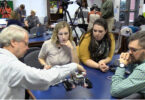Middle school kids have a reputation for being loud, crude, hormonally unstable, and obsessed with any number of things. A small number of youth begin to develop serious delinquency problems in the middle school years.
“Without the necessary social skills to solve problems in a positive way, they are likely to respond to social and academic pressures with verbal and physical aggression,” says Institute for Behavioral Research Fellow Pamela Orpinas. Orpinas, a professor in the College of Public Health’s department of health promotion and behavior, has worked in the area of prevention of youth violence and bullying for 15 years.
She and Andy Horne, a professor in the College of Education’s department of counseling and human development services, have written a book called Bullying Prevention: Creating a Positive School Climate and Developing Social Competence that is based on the notion that bullying is a preventable health problem. “We present a model that helps readers understand what bullying is and how to prevent it,” she said.
Orpinas insists that effective teachers have fewer problems with bullying. “You need a classroom climate where students and teachers are respectful of one another and do not accept even small put-downs,” she said. “Teachers must stop them right away, talk about it, and teach an alternative way of interacting. Through this process, students come to know that teachers really care about them.”
Students learn social, emotional and cognitive skills to handle conflict and initiate positive behavior using the model. “We help them give compliments and say positive things to each other,” Orpinas explains. “Teachers are fascinated at how kids change. Just like adults, kids don’t like being bullied. They enjoy a positive, respectful atmosphere.”
Of course, bullying is a problem whose roots extend beyond school. Violent behavior is the result of the interaction of many factors at work in a child’s life, from individual characteristics to the family to the culture at large, particularly as it is reflected in the media. Orpinas mentions several video games based on children and adolescents bullying others.
“It’s unbelievable that we have these games,” she says, “but they are less likely to influence the behavior of a child who has positive influences. A kid with more risk factors may be impacted in a more dramatic way by these games.”
Orpinas and Horne have been involved in a CDC-funded project to evaluate interventions most likely to reduce aggressive behavior in middle school students. Offered to students identified by teachers as having behavior problems, these students and their families attended weekly multi-family group meetings where they discussed parenting skills, family problem solving, communication skills, and family support for appropriate behavior at school. The results will be presented in January.








